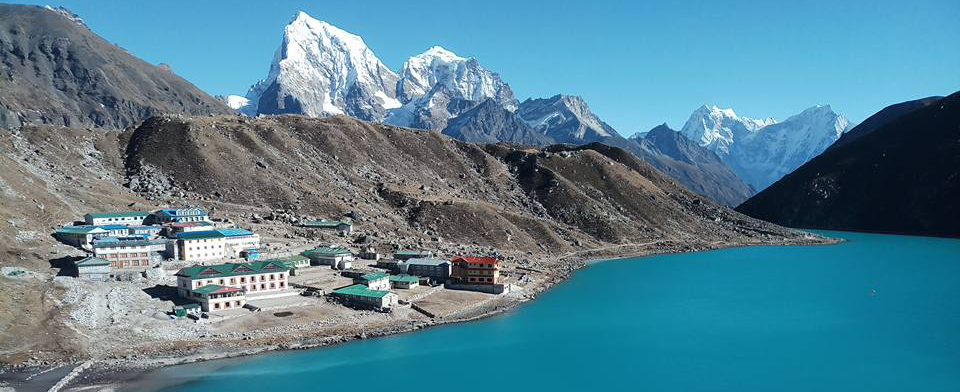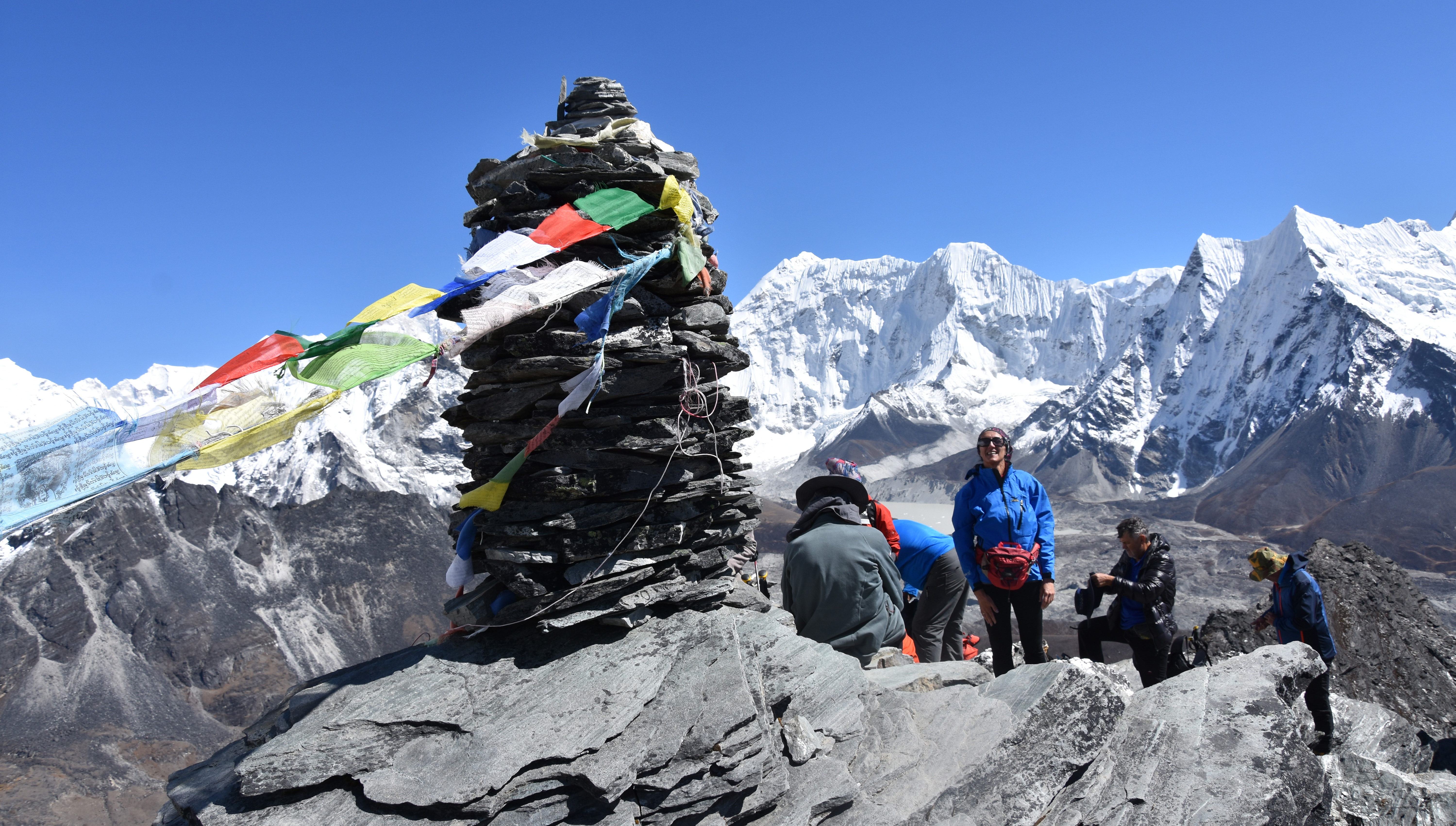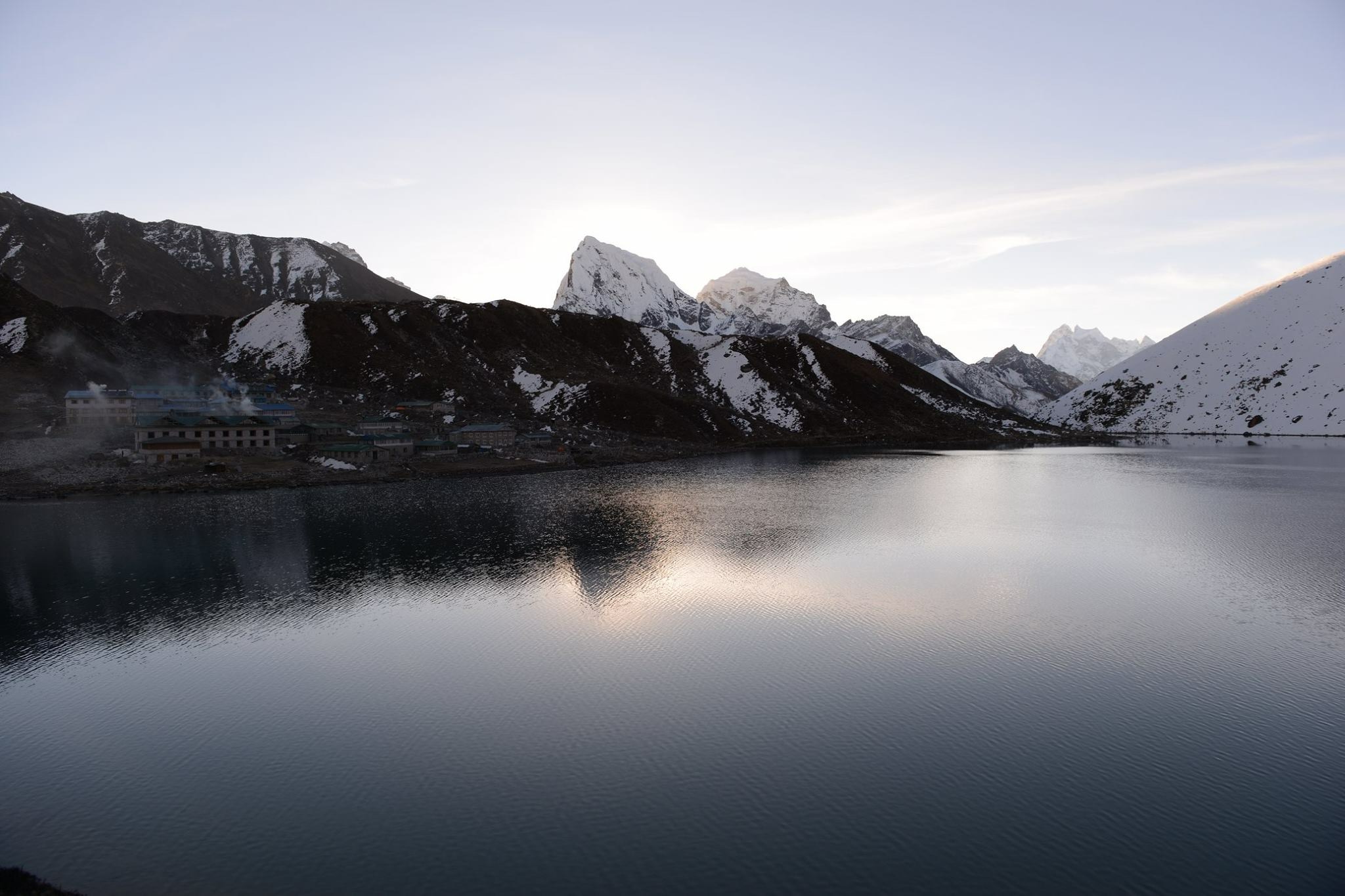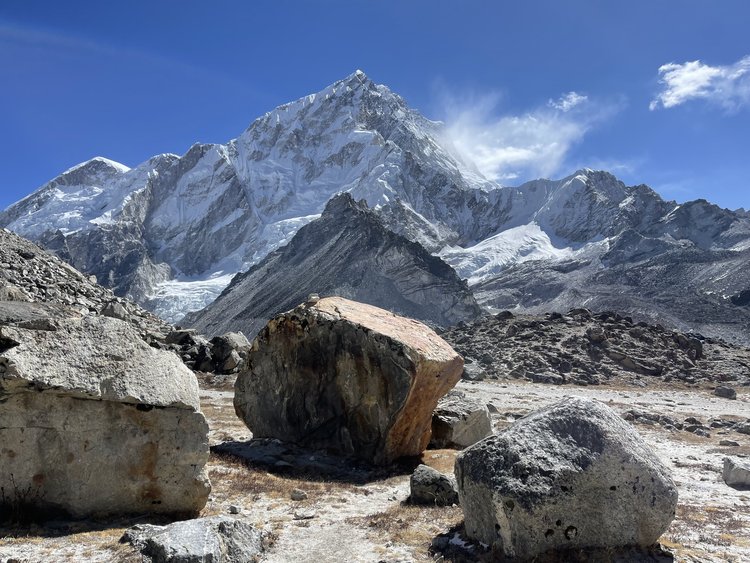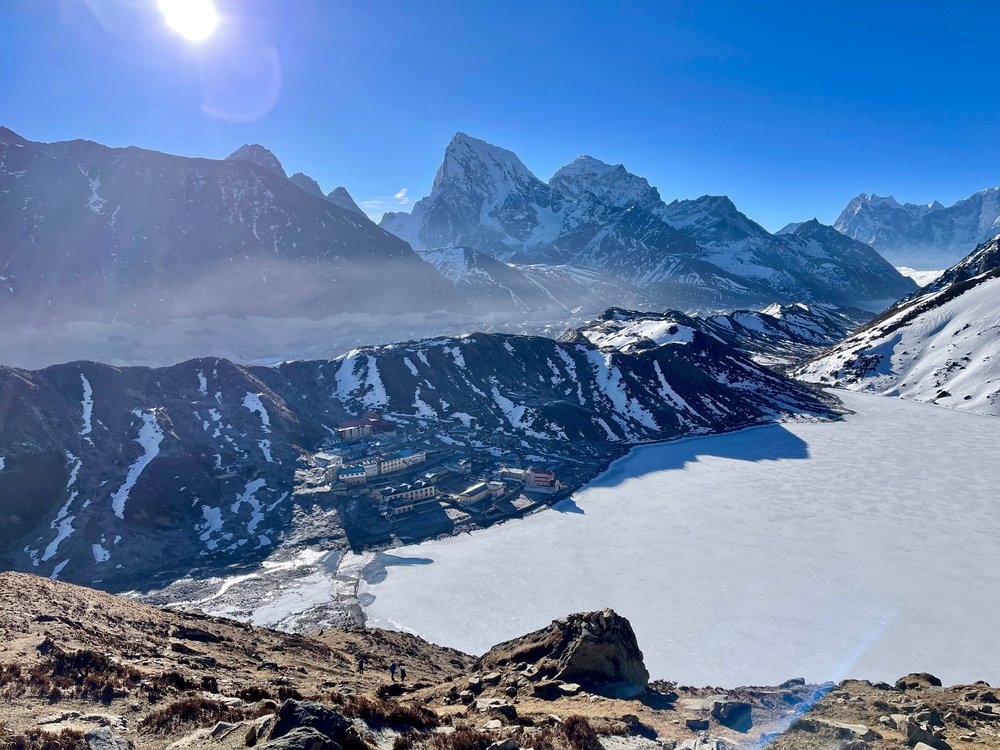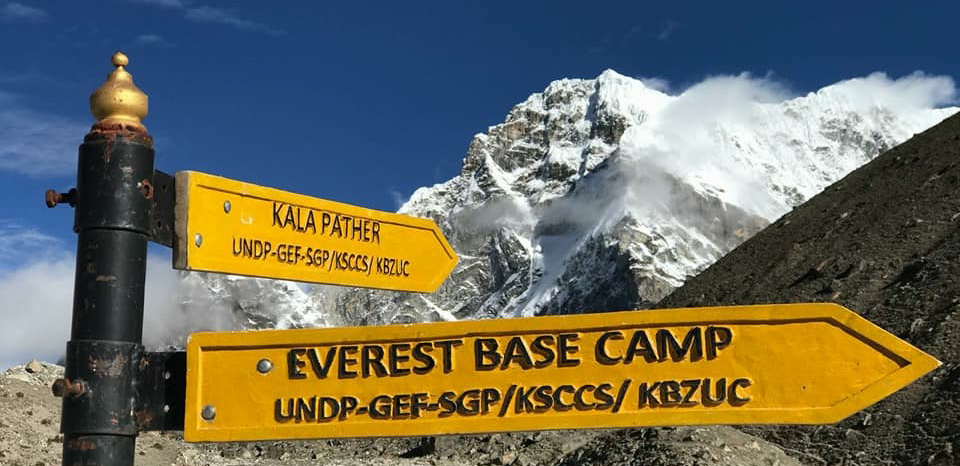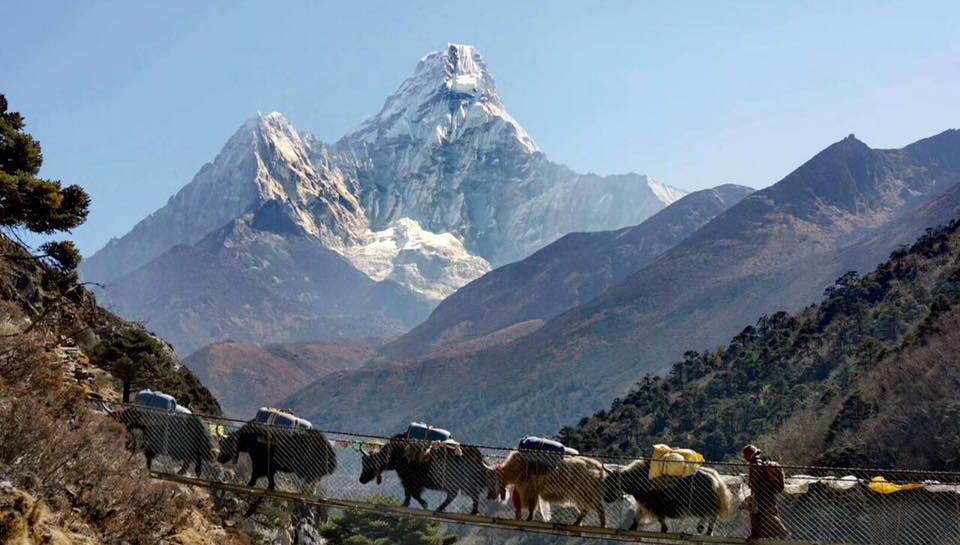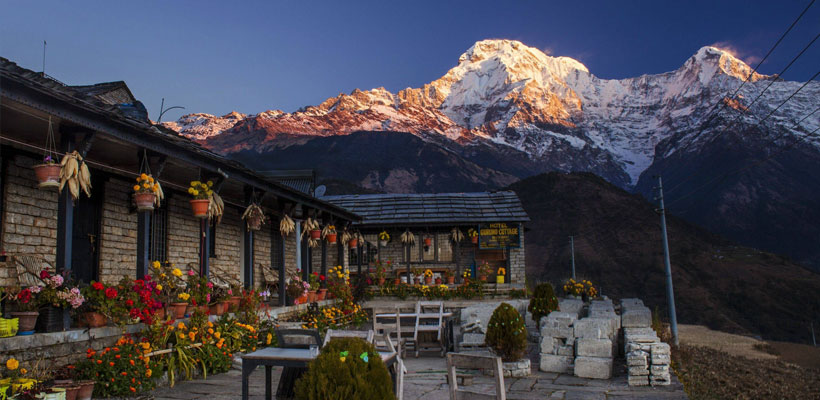Everest Base Camp with Gokyo Trek
Everest Base Camp with Gokyo Trek is the famous trekking route in Nepal. After arrival in Kathmandu, we go sightseeing around Kathmandu valley. The next morning we take a flight to Lukla, which also takes us to the gateway of the Everest region. There are many majestic rivers with exciting suspension bridges laden with prayer flags. This trek also takes you close to Mt. Everest without mountaineering equipment. We can see the spectacular view of the Khumbu Icefall from Base Camp. The climber gets the most magnificent mountain panorama on the highest point on the planet at 8,848m. Also, we can see the giants such as Nuptse, Chagatse, Lhotse and countless others. Start your journey to the Everest Base Camp for one of the most memorable treks you will ever encounter.
Himalaya Sanctuary Adventure has created this trip to meet and exceed customer satisfaction in luxury, quality and experience. The lodging choices along the route are designed to entail the best the country has to offer. Himalayan Sanctuary Adventure has also mixed together the highest standard accommodations with local flavor guaranteeing the sound sleep of our guests in the most comfortable environment available. This deluxe trip comprises 5-star hotel in Kathmandu and also the best lodge along the trek.
Day 01: Arrival at Kathmandu airport (1,400m).
Day 02: Kathmandu Sightseeing.
Day 03: Fly to Lukla (2,804m) and Trek to Phakding 3.5 hours.
Day 04: Trek to Namche Bazar (3,840m)-5 hours.
Day 05: Namche Bazar Acclimatization day.
Day 06: Trek to Pangboche (3,930m) 6 hours.
Day 07: Trek to Dingboche (4350 m) 6 hours.
Day 08: Trek to Chhukung (4710m) and Back to Dingboche – 4.5 hours.
Day 09: Trek to Lobuche (4,910m) 5 hours.
Day 10: Trek to Everest Base Camp (5,365 m) then Back to Gorak Shep (5,180 m) – 8 hrs.
Day 11: Hike up to Kalapatthar (5,555m), early in the morning and trek down to Dzongla (4,710m) – 7 hrs.
Day 12: Cross Chola Pass (5,300m) and Trek to Gokyo (4,790m)-8 hours.
Day 13: Trek to Gokyo Ri (5,483m) and back to Gokyo- 5 hours.
Day 14: Trek to Dole (4,200m) – 6 hours.
Day 15: Trek to Namche Bazaar (3,441m) via Khumjung Village (3,780m).
Day 16: Trek to Lukla (2,804m) – 6 hours.
Day 17: Morning flight back to Kathmandu.
Day 18: Final Departure.
Day 01: Kathmandu Arrival (1,350m/4,428ft)
Our Representative will be waiting for you outside the arrival terminal gate and You will be transferred to your hotel. Overnight at your hotel in Kathmandu
Day 02: Kathmandu Vally Sightseeing(4- 6hr)
Full-day Sightseeing of Kathmandu Vally .after breakfast in the morning you will be Proceed on to Boudhanath Stupa, Pasupatinath Temple, Patan Darbar Square and Swayambhunath Stupa. Swayambhunath is a Buddhist Stupa said to be more than 2000 years old, is perched on a hillock 77 meters above the valley floor and offering a bird’s eye view of Kathmandu City. Afternoon, a tour of Patan, also known as Lalitpur or the “city of beauty” is the oldest city in the valley. A great center both of the Newari Buddhist religion and of traditional arts & crafts with 136 bahals or courtyards and 55 major temples.
- Boudhanath Stupa, Lies about 6 kms to the east of downtown Kathmandu and is the largest stupa in the valley. It looms 36 meters high and presents one of the most fascinating specimens of stupa design. Buddhanath is also known as Khasti, or dew drops, after an account that builders had to use dew to mix the mortar as Kathmandu was suffering from a severe drought during the construction of Bouddhanath.
- Pasupatinath Temple, Pashupatinath is one of the most sacred Hindu shrines in the world and lies 5 kms east of the city center. The richly-ornamented pagoda houses the sacred Linga, or phallic symbol, of Lord Shiva. Chronicles indicate the temple’s existence prior to 400 AD. Devotees can be seen taking ritual dips in the holy Bagmati River flowing beside the temple
- Patan Darbar Square, Patan Durbar Square is an enchanting combination of palace buildings, artistic courtyards and graceful pagoda temples. The former royal palace complex is the center of Patan’s religious and social life, and houses a museum containing an array of bronze statues and religious objects. One remarkable monument here is a 17th-century temple dedicated to the Hindu god Krishna, built entirely of stone
- Swayambhunath Stupa, The Monkey Temple (World Heritage Site) Watches over the valley from the top of a hillock on its western side. The huge stupa is one of the holiest Buddhists sites in Nepal and its establishment is linked to the creation of the Kathmandu Valley out of a primordial lake. Swayambhu is also known as Samhengu and the Monkey temple because of the countless monkeys living in the premises
Included Meal: Breakfast
Day 03: Kathmandu – Lukla – Phakding(2,651m/8,700ft): 40 minutes flight, 3 – 4 hours trek
We take an early morning flight to Lukla and meet the rest of the crew members in Lukla and start our trek. The trail then leads to Phakding via Cheplung village from where we get a magnificent view of Mt. Khumbila, a sacred mountain that has never been summited.Overnight at Yeti Mountain Home.
Breakfast Included.
Day 04: Trek to Namche Bazaar (3,441 m) – 5 hours
We continue trekking along the banks of the Dudh Koshi, crossing the majestic river many times on exciting suspension bridges laden with prayer flags. After entering the Sagamartha National Park, the trail climbs steeply with breathtaking views. Namche Bazaar (considered the ‘Gateway to Everest’) is home to many quality restaurants, hotels, lodges, shops, money exchange services, internet cafes and bakeries. Namche is the biggest town along the Everest trail. Overnight at Yeti Mountain Home or Hotel Namche or similar class Guesthouse.
Breakfast included.
Day 05: Namche Bazaar Acclimatization Day
We will spend a day in Namche Bazaar in order to acclimatize and adjust to the thinning air. We will trek a short distance to a museum that is celebrated for its exhibits of the traditional customs of the Sherpa people. We will also hike up to Syangboche Airport and the Everest View Hotel, one of the highest-placed hotels in the world. From this point, we can see rewarding views of the Himalayas including Mt Everest. Overnight at Yeti Mountain Home or Hotel Namche Guesthouse.
Breakfast included.
Day 06: Trek to Pangboche (3,930 m) – 6 hours.
The trek continues along the rushing glacial waters of the Dudh Kosi with magnificent views of the mountains. We trek to an altitude of 3,930m / 12,893ft today. On reaching Tengboche you will see the local monastery. Inside the monastery are incredibly ornate wall hangings, a 20-foot sculpture of Buddha, and the musical instruments and robes of the Lamas. From Tengboche, the trail drops to Debuche, crosses another exciting suspension bridge on the Imja Khola, and climbs to Pangboche village. Overnight at Everest Summit Lodge or similar class Guesthouse.
Breakfast included.
Day 07: Trek to Dingboche (4350 m) -6 hours.
Our uphill trek continues, taking us to the quaint traditional Sherpa village of Dingboche with its exquisite views of Lhotse, Island Peak, and Ama Dablam. We take our time so we avoid getting affected by the altitude. Overnight at Hotel Bright Star or similar class Guesthouse.
Breakfast included.
Day 08: Trek to Chhukung (4710 m) and Trek Back to Dingboche – 4.5 hours.
On this day you can enjoy another day for acclimatization. We will have a trip to Chhukung valley via the Imja Khola valley to get a marvelous view of the surrounding mountains, especially Lhotse’s massive south wall, then return to Dingboche in the evening. Overnight at Hotel Bright Star or similar class Guesthouse.
Breakfast included.
Day 09: Trek to Lobuche (4,910 m) – 5 hours.
Today, the trail continues along the lateral moraine of the Khumbu Glacier and passes by stone memorials for climbers who have perished on nearby summits. We continue to climb as we are heading to the altitude of 4,910m / 16,018ft at Lobuche, which is really just a few huts at the foot of a giant Lobuche peak. Some breathing problems may arise today due to the altitude. Overnight at Hotel Oxygen or similar class Guesthouse.
Breakfast included.
Day 10: Trek to Everest Base Camp (5,365 m) and Back to Gorak Shep (5,180 m) – 8 hours
This is a big and difficult day to walk along the Khumbu Glacier and up to Everest Base Camp at 5,365 m, the closest you can get to Mt. Everest without mountaineering equipment. During spring, there will likely be expedition teams about to attempt the summit. The view of the Khumbu Icefall from Base Camp is spectacular. We return back to Gorak Shep for the night. Overnight at Hotel Yeti or similar class Guesthouse.
Breakfast included.
Day 11: Morning Hike up to Kala Patthar (5,555 m) and Trek Down to Dzongla (4,200 m) – 7 hours
This will be one of the most difficult yet rewarding days of the trek. Most of the morning is spent climbing Kala Patthar, a small peak at (5,555 m). The ascent is demanding but the climber gets the most magnificent mountain panorama – Everest, the highest point on the planet at (8,848 m), towers directly ahead and on all sides loom the giants such as Nuptse, Pumori, Chagatse, Lhotse and countless others. We make a quick descent to Gorak Shep and have hot breakfast, and then trek down to Dzongla. Overnight at Hotel Green Valley or similar class Guesthouse.
Breakfast included.
Day 12: Cross Cho La Pass (5,300 m) and Trek to Gokyo (4,790m) – 8 hours
Early morning, we start our trek towards Cho La Pass because at the daytime it will be difficult to cross the high pass due to strong wind and possibly snow. It is a tough walk but it will be worth by the beautiful natural beauty of the Himalayas. After crossing Cho La Pass we walk down towards Gokyo to spend the night there. Overnight at Hotel Eco Himalaya or similar class Guesthouse.
Breakfast included.
Day 13: Trek to Gokyo Ri (5,483 m) and Back to Gokyo – 5 hours
Early in the morning, we have a steep climb up to the top of Gokyo Ri at an elevation of 5,483 m. There are ample rewards for those who attempt this trip. You get stunning views of the super Gokyo valley, the massive Ngozumpa Glacier and an incredible panoramic view of the whole Khumbu Himalayas, including the giants Everest, Lhotse, Nuptse, Makalu, Cho-Oyu and Gychung Kang. Overnight at Hotel Eco Himalaya or similar class Guesthouse.
Breakfast included.
Day 14: Trek to Dole (4,200 m) – 6 hours.
Today we hike towards downward to Dole. Up to Machhermo, it is quite steep but after that, it is an easy trail down to Dole. Overnight at Hotel Namaste or similar class Guesthouse.
Breakfast included.
Day 15: Trek to Namche Bazaar (3,441 m) via Khumjung (2,780 m) – 5 hours
From Dole, we descend steeply through beautiful forests of juniper, rhododendron, and fir to Phunki Tenga. After a welcome break and a cup of tea, we cross the Dudh Kosi River and climb to Trashinga. From here the trail contours high above the valley through to Shanasa, where we have the option of visiting Kunde and Khumjung villages before returning to Namche Bazaar – our stop for the night. Overnight at Yeti Mountain Home or similar class Guesthouse.
Breakfast included.
Day 16: Trek to Lukla (2,804 m) – 6 hours This is our last day of trekking as we return to Lukla where the trek began. We enjoy this time to reflect on the trek as a group and the personal achievement of all those who took part. The afternoon is free, so you can wander about, relax and enjoy a hot shower! In the evening, have a few celebratory drinks and dance with your trek mates. Overnight at Yeti Mountain Home or similar class Guesthouse.
Breakfast included.
Day 17: Morning Flight from Lukla to Kathmandu
35 minutes scenic flight takes us back to Kathmandu. On arrival in Kathmandu, we are met and transferred back to our starting hotel. In the evening we will host farewell dinner in a traditional Nepalese restaurant with cultural performances. Overnight at Yak and Yeti Hotel or similar class Hotel.
Breakfast included.
Day 18: Transfer to the International Airport for Your Departure
Our airport representative will drop you to Kathmandu’s Tribhuwan International Airport for your flight departure from Nepal.
Breakfast included.
Price Included
- Airport Transfer.
- Sightseeing in Kathmandu Valley.
- 5 star category Accommodations with Breakfast on Twin Sharing in Kathmandu
- Teahouse/Lodge including Breakfast,Lunch and Dinner on twin sharing basis During Trekking
- Well Experienced, Professional & Trained guide with meals, lodge, gears, Insurance and wages & Porter( 1 porter for 2 people, max weight 15 kgs) with meals, lodge, gears, Insurance and wages
- Duffel bag
- Trek permits, National Park fee, TIMS card and required trek documents
- Kathmandu – Lukla – Kathmandu by Flight & Airport taxes.
- First Aid Kid Box( for basic Treatment only)
- Trekking completion certificate for memory of wonderful Nepal Trek
Price Excluded
- Nepal Visa fee
- Tour Guide and entrance Fees For Sightseeing in Kathmandu.
- Travel and Emergency Helicopter Evacuation Insurance
- Lunch & Dinner in Kathmandu.
- Any soft drinks or Alcoholic drinks during trek
- Laundry or personal expenses like phone calls, unforeseen cost due to landslide, sick,Tea, Coffee, hot and cold Drinks, hot shower flight delayed, bad weather, Urgent Helicopter Evacuation etc
- Trekking gears and clothing
- Tips for guide and porter( Highly expected)
The following gives you a general idea of the personal items that you need to bring for the trek. The personal items are of individual interest and choice. The most important fact that one should keep on mind is that one should have enough clothes to tackle the cold weather in the Himalayas.
General
- 4 seasons Sleeping bag.
- Duffel or Rucksack bag or suitcase.
- Daypack
- Down Jacket.
Upper Body – Head / Ears / Eyes
- Shade hat or baseball cap – some people drape a bandana down the back of their head and then put a baseball cap on to hold it in place. This can be a flexible alternative while keeping the sun off your ears and neck.
- Warm wool or synthetic hat that covers your ears.
- Balaclava – lightweight, thinner variety.
- Glacier glasses-100% UV protection with side shields and a hard-sided storage case (i.e. Julbo or Cebe). This is to protect your eyes from the stronger rays of the sun due to the thinner atmosphere which can cause a painful condition known as snow blindness. Regular sunglasses are not sufficient. If you wear prescription glasses, speak to your doctor about prescription glacier glasses, perhaps with transitional lenses.
- Headlamp – Black Diamond and Petzl both make several good ones. Make sure to bring extra batteries and that they are lithium batteries so that they will last in the colder temperatures. These are indispensable for getting around at night; reading, etc. so, don’t go cheap here.
- Some people like ear-muffs; These are optional; a good hat, balaclava, and hooded jacket should really be sufficient, but this is a personal choice for some people (optional).
- A neck warmer is another piece of gear for extra warmth if you feel you will need it (optional).
Hand
- 1 pair liner gloves, thin wool or synthetic, useful alone on mild days or as a layer inside other gloves/mitts for additional warmth.
- 1 pair of warm gloves (heavier fleece or wool).
- 1 pair shell gloves or mitts; Gore-Tex is preferred for keeping hands dry.
- Instant hand warmers are always nice in a pinch, but really shouldn’t be necessary on the trek. Bringing appropriate hand protection as recommended above should be sufficient (optional).
Core Body
- Light and expedition weight thermal tops.
- T-shirts (2).
- Fleece jacket or pullover.
- Fleece Wind-Stopper jacket (optional).
- Waterproof (preferably breathable fabric) shell jacket.
- 2 women sports bras, Synthetic, no cotton!
Lower Body – Legs
- 2 pair’s nylon hiking shorts – Quick drying type, not cotton!
- Underwear, stay away from cotton (4).
- 2 pairs’ lightweight long underwear – Capilene or other synthetic.
- 1 pair soft shell pants – synthetic, full zip from top and bottom preferable.
- A pair of good Goretex pant
- 2 pairs trekking pants, preferably that zip on/off at the knees so they double as shorts.
- 1 pair of hard shell pants. Waterproof/breathable, Gore-Tex or equivalent is best. Should zip from the top and bottom – this makes it easier to put on over boots without getting undressed should the weather change once you are underway for the day.
- 1 pair of cotton pants (loose jeans/khakis).
- All clothing should be kept dry using waterproof stuff sacks or large puncture resistant plastic bags.
Feet
- 4 pairs of liner socks, synthetic or Capilene.
- 3 pairs of heavyweight socks to be worn over liner socks.
- 1 pair lightweight socks, a good option for the lower / warmer parts of the trail.
- 1 pair light to medium weight waterproof hiking/trekking boots. Ensure a good fit with layered socks and you have worn then before to get used to it (otherwise you will get lots of blisters).
- 1 pair of light trekking shoes or sneakers. Good for around the camp/lodges and in Kathmandu.
- 1 pair hiking gaiters, good for keeping dust and rocks out of your shoes/boots as well as keep your feet dry as necessary (Optional).
- 1 pair of sandals (Optional).
Medicines and First Aid Kits
- Extra Strength Excedrin for altitude related headaches.
- Ibuprofen for general aches and pains.
- Immodium or Pepto Bismol capsules for upset stomach or diarrhea.
- Diamox (commonly prescribed as Acetazolamide) 125 or 250mg tablets for altitude sickness. Please discuss this with us before starting to take this medicine.
- 1 small personal sized first-aid kit with blister treatments such as moleskin, band-aids, some waterproof tape, anti-infection ointments, etc. Your guides will have more extensive medical gear, but you should have the basics for general use.
Miscellaneous, but Important!
- Passport and extra passport photos (4 copies).
- Airline ticket (Please make a copy and leave on at our office in KTM just in case if you need to change the date of your).
- Durable wallet/pouch for travel documents, money & passport.
- Lip balm. At least SPF 20, 2 sticks. A string taped to the stick is helpful, to hang around your neck and some are now being sold with a cord already attached. Handy as it avoids you from having to stop and look for it.
- SPF 40 is recommended and should be relatively new since it loses its’ effectiveness over time.
- Pocket knife or small Swiss Army type.
- Water purification Iodine tablets or Polar-pure crystals.
- Toiletry kit. Be sure to include toilet paper stored in a plastic bag, hand wipes, and liquid hand sanitizer, towel, soap, etc.
- 2 bandanas.
1. Will somebody come to pick me up ?
Representative from Himalayan Sanctuary Adventure will pick you up from Tribhuvan International Airport in Kathamndu .
2. What sort of accommodation can I expect in trekking?
Normal Teahouses/lodges will be provided along the trekking routes in the mountains. The lodges in trekking routes usually provide single and double rooms. At times when possible, dining will be around a bonfire. In tea houses, food will be prepared in the kitchen which you should not enter without permission. somewhere until Dingboche, you will have attached toilet and bathroom. But in two locations Lobuche and Gorakshep, you will have to use a common toilet and bathroom. (depend on Season)
3. Is it possible to swap my accommodation from mountain guesthouse to hotels in Kathmandu?
Substituting the accommodation or swapping from the mountain guest house to Kathmandu is NOT possible. We only provide two nights’ accommodation in Kathmandu included in the package. In case of flight cancellation or early arrival to Kathmandu due to any sickness in the mountain or any of your own personal reason or due to bad weather and you are unable to continue the trek, you will need an extra night accommodation/s in Kathmandu. We can make these arrangements for a supplemental charge.
4. Is it possible to reserve a trip now and pay a deposit later or do I Have to pay a deposit at booking/reservation?
Yes! The trip will be confirmed only when we receive the completed final booking form and a 30% deposit payment. You can pay the balance of the money when you arrive in Kathmandu.
5. Is there a possibility of getting separate rooms for the trip?
During the trek, we will try our best but normally the lodges have twin sharing and dormitory styled room instead of a single room.
6. Is this a guaranteed departure even if I am alone stating in the request trip?
Yes, all our trips are guaranteed to run. We never cancel the trip due to not having enough participants, we can arrange the trip for one person as well.
7. When I pay the remainder of the money on arrival in Kathmandu, how do you take that money? US cash or credit card?
You can clear the remainder of the money upon your arrival in Kathmandu or even before you arrive in Kathmandu. You can use USD, Euro, Pound, Canadian Dollar, Swiss franc in cash, Master or Visa cards for the payment options. There will be 4% bank levy when paying by credit card.
8. What sort of food can I expect in trekking?
Most teahouses (lodges) in Everest Base Camp trails cook a delicious range of mostly vegetarian fare. Pasta, tuna bakes, noodles, potatoes, eggs, daal Bhat (rice and lentils), bread, soup, fresh vegetables (variety depends on the season) and even some desserts like apple pies, pancakes, and some interesting attempts at custard. You will find a lot of garlic on the menu because it assists with acclimatization – eat some every day. In many larger villages, you may find some meat items on the menu. You can always get hot chocolate, tea, and hot lemon drinks, as well as soft drinks, and treats like chocolate and crisps. Each day dinner and breakfast will be at a lodge you’ll stay at while lunch will be taken on the way to the destination
9. Is the food in the mountain prepared to international standard in terms of safety?
YES, the food is very safe during the trekking but we recommend you to eat vegetarian and local food. Please follow the suggestion of our guide on the trek.
10. Is water provided and is there still water available at higher altitudes? Is it filtered/boiled? Readily available?
Bottled water is easily available at the lodges and tea houses. You can buy bottled water at the cost of USD $ 2 at lower elevations to USD $4 to higher elevation per littler. You can also drink the normal tap or spring water if you bring the purifying aid with you.
11. What is the alternative option if my flight to and from Lukla is canceled or delayed?
Sometimes, flights (to and from Lukla) may be canceled due to mountain weather conditions or technical issues. In such a case, Himalaya Sanctuary Adventure can help you charter a helicopter to ensure you are on schedule for your trek or international flight. The helicopter can fly if the visibility is 1500m, while the twin otter and Dornier can fly if the visibility is 5000m, as per Nepal’s Civil Aviation rules. If the weather is extreme and the visibility is lesser than 1,500m helicopters are also not operated for the flights. In such cases, we will reschedule your flight for the next day provides you alternative trek options.
12. How much should I pay for the Heli charter?
The cost of the helicopter is payable directly to our Kathmandu office in the event that this service is utilized. US cash or credit cards (Visa Cards, Master Cards only) are accepted. You will be given a receipt upon payment so that you may claim the amount from your travel insurance. The extra charges incurred are approximately $2,500 to $3,000 USD per helicopter (minimum USD 500 to maximum USD 3,000 per person) would be applicable to you for the helicopter charter. Usually, the helicopter takes only 3 to 5 passengers at a time. Therefore whatever the cost of a helicopter is, the price is divided among the group members. Any card payment requires a 4% bank fee while doing the transaction, which is taken by the bank itself. (Himalayan Sanctuary Adventure doesn’t own any of those 4% amounts)
13. What is the best season for this trekking?
Our trekking season extends from mid- September to May. From early September the monsoonal rains decrease. By the end of September through to December, the weather is usually stable with mild to warm days, cold nights. February, March, April, May, October, November, December is the best time to do Everest base camp deluxe trek
14. What sort of weather condition and temperature will be in Trekking?
Here are some weather basics to help ensure that you come to the Himalayas as well equipped and prepared to face anything. During the day, the thermometer could reach temps as high as 25 degrees C, only to dip down as low as -20 degrees C in less than 24 hours.
Spring – March / April / May / June : Spring happens to be one of the best times of the year to visit the Everest region, although because of this, it can become somewhat crowded. During springtime, the average temperature is 17 degrees C with a maximum of 25 degrees C during sunny days and a minimum of -15 degrees C in the morning and at night for areas above 4000 meters.
July / August : Through Mid-September is Monsoon Season This season is not really recommended to travel as it rains in the lower altitudes, below 3500 meters. In areas above 4000 meters, it rains sometimes and although it is also sometimes dry, very few people travel during this season. There are positives to trekking during the monsoon months, however. The excess rainfall can provide ample chance to see spectacular views of the waterfall and it’s also the best season to avoid the crowds. The maximum temperature during the monsoon season averages 25 degrees C during sunny days with a minimum -15 degrees C in the morning and night at areas above 4000 meters. The average temperature tends to hover around a comfortable 18 degrees C.
Autumn – End of September / October / November : Similar to springtime, autumn in the Everest region is also a crowded season, but it’s one of the best times to trek. While it lacks the beauty of flowers, the clear blue sky can be seen, affording incredible views from just about every angle. The average temperature during the fall is 15 degrees C with a maximum temp of 20 degrees C during sunny days and a minimum of -10 degrees C in the morning and at night, for areas above 4000 meters altitude.
Regardless of the time of year, trekkers should always plan accordingly and bring clothing for both cooler and warmer temps. Layering is always recommended, as are pants that can double as shorts.
15. Can I obtain a visa for Nepal upon arrival at the airport?
YES, you can obtain a visa easily upon your arrival at Tribhuwan International Airport in Kathmandu. Tourist Visa with Multiple Entry for 30 days can be obtained by paying the US $ 40 or equivalent foreign currency. Similarly, Tourist Visa with Multiple Entry for 90 days can be obtained by paying the US $ 100. Please bring 2 copies of passport size photos.
16. What if I am very sick in the mountain?
Our guides are 24 hours available for the services during the trek. They are trained to use the first aid kit and have the knowledge to use Oxy meter. They are very much aware that higher the altitude the oxygen level gets lesser so to get updated on the oxygen level of our client and to know whether they are fit enough or needs extra precautions to continue. During the time of emergency, our guides are alert and keep updated to head office in Kathmandu that is available 24 /7 to arranging from horse to mules or helicopters in the must needed cases especially when the client is seriously sick in the mountain and needed to be hospitalized.
17. What immunizations will I need?
No vaccinations are compulsory in Himalaya, but we do recommend you are covered for diphtheria & TB, hepatitis A, hepatitis B, *malaria, typhoid, polio, and tetanus. We also recommend: · A dental check-up prior to traveling. · That you know your blood group in case of emergency.
18. What is your cancellation policy?
Cancellation notice is required, a minimum of 20 days prior to trip departure. If the reason is valid the trip shall then be termed as canceled and the cancellation charge of 30% of the trip amount would be deducted from the advance paid. If you do not cancel your trip prior to 20 days due to whatsoever reasons, you must be aware that the trip you’ve already bought is completely non-refundable as per our terms and conditions. If your trip is cut short due to weather/illness/personal reasons, there is no refund for accommodations unused.
| Start Date | End Date | Price in USD | Availability | Booking | Note |
|---|
Avabillity Options
OPEN: This date is available and open for bookings. Go for it!
GUARANTEED: Guaranteed departure. Seat Available.
LIMITED: Guaranteed departure, Limited seat. You can send booking request for availability.
FULL:This date is currently unavailable. Please contact us if you are interested in traveling on this date.

